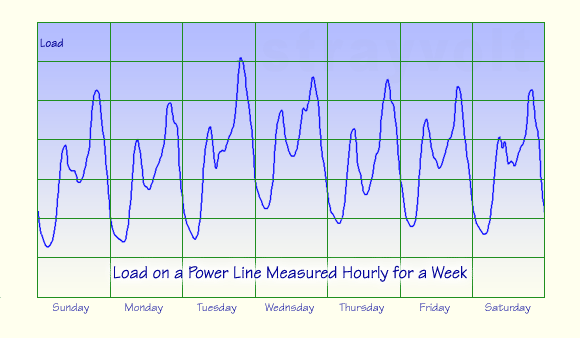Long-Term Variability (Steady State) |
|
|
|
As we have seen, a natural consequence of operating a safely grounded
electric power system is that some current flows in the earth where
it creates voltage gradients and a field of stray voltages on the surface of the earth.
Consequently, some of the changes in the
electric load on a power system affect the level of stray voltages.
|
|
In power engineering, the term load refers to the amount of electric
energy flowing on the power system at one time. Load is like traffic on a highway.
The number of vehicles moving at one time on the road is a function of
the independent actions of many drivers on the same highway.
The amount of load on an electrical system is dictated by customer usage.
|
|
The amount of electric energy flowing on a power system at any given point
depends on the combination of voltage and current at that point.
The operating voltage of a power system is typically fixed at a
chosen value;
therefore, it is the change in current level as determined by customer usage
that accounts for changes in energy levels. Zero current, for example,
means that there is no power flowing on the system. With no energy and
no current flowing, there can be no stray voltage.
|
 
|
Based on the length of time considered, long-term electrical load variations may be characterized as:
- instantaneous changes: unpredictable minute-to-minute variations as load is switched in and
out at various locations
- short-term, recurring changes, as in the cyclical changes from day to day
- long-term trends, as in seasonal rotations
We will now look at each of these categories to learn about some of their special features.
|
|
It should be noted that the electric system is at steady state in each of these cases.
In engineering dynamics, systems are either in transition (transient state),
such as when a motor is started and is speeding up, or operating steadily (steady state),
such as when a motor is running evenly. Slow changes in electric load,
changes on a utility network from midnight to morning for example, are slow enough that the electrical
system can adjust smoothly and imperceptibly, without experiencing the dramatic changes of transients.
|
 
|
 Instantaneous Changes
Instantaneous Changes |
|
Load at a utilization point (e.g. farm, residence, etc.) varies considerably from minute
to minute as shown in the figure below. This is a recording of the load measured
every minute for an hour on a customer's electrical service.
The changes are the result of many fixtures and appliances being turned on and off
in an apparently random fashion.
|

|
 
|
 Short-Term Cycles
Short-Term Cycles |
|
The figure below shows load as it varies cyclically from day to day over a week
on a typical rural power line in the Midwest. The repeated 24-hour cycle starts
out at the bottom in the early morning hours, peaks briefly in the morning,
drops down at midday, and peaks strongly in the evening. Because stray voltage
is indirectly related to system loading, it can be expected to have a similar
daily cycle. The figure clearly indicates that the worst case of
stray voltage can be expected in the evening hours, at the peak of the daily cycle.
In trying to mimic worst-case conditions, stray voltage investigators will
at times use artificial loads to re-create evening loading conditions when performing tests
midday, during normal working hours.
|

|
 
|
 Long-Term Trends
Long-Term Trends |
|
The following figure shows load measured daily over a year on a rural power line in the Midwest.
The load varies during a year-long cycle that peaks
in winter and bottoms out during spring and fall. During summer, load peaks out again and
varies erratically because of hot weather and the use of air conditioning.
Similar long-term variations near the farmstead may affect stray voltage levels.
|

|
 
|
|
Stray voltage will inherit much of the time variability of load (system usage),
and therefore may have characteristics of either steadiness
or variability, depending on the time frame. |
|
As we have mentioned, load also varies from point to point on the power delivery system.
The load relevant to stray voltage at any given farm is the load on the power system
near the farmstead where stray voltage is being analyzed. In fact, the load most
relevant to stray voltage levels is almost always the electrical load of the
farm being analyzed.
|
|
An assessment of exposure of dairy cows to stray voltage must address some
of these time variabilities. Stray voltage investigators often use artificial
loads as indicated above, or use farm loads sufficient to accurately represent
loading that would occur during higher usage periods.
|
|
|





|
